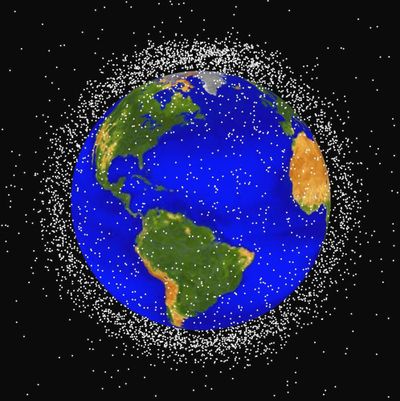Can’t sweep this under the rug
Orbit-clogging space junk may force Earthlings to clean up the clutter

WASHINGTON – Space junk has made such a mess of Earth’s orbit that experts say we may need to finally think about cleaning it up.
That may mean vacuuming up debris with weird space technology – cosmic versions of nets, magnets and giant umbrellas, according to the chairman of an expert panel that issued a new report on the problem Thursday.
There are 22,000 objects in orbit that are big enough for officials on the ground to track and countless more smaller ones that could do damage to human-carrying spaceships and valuable satellites. The International Space Station has to move out of the way of debris from time to time.
“We’ve lost control of the environment,” said retired NASA senior scientist Donald Kessler, who headed the National Academy of Sciences report.
Since the space age began 54 years ago, civilization has littered the area just above Earth’s atmosphere with leftover boosters and other parts that come off during launches, as well as old satellites. When scientists noticed that this could be a problem, they came up with agreements to limit new space junk, and those plans had been working.
Those agreements are intended to make sure what is sent into orbit eventually falls back to Earth and burns up.
But two events in the past four years – a 2007 Chinese anti-satellite weapon test and a 2009 crash-in-orbit of two satellites – put so much new junk in space that everything changed, the report said. The widely criticized Chinese test used a missile to smash an aging weather satellite into 150,000 pieces of debris larger than four-tenths of an inch, and 3,118 pieces can be tracked by radar on the ground, the report said.
“Those two single events doubled the amount of fragments in Earth orbit and completely wiped out what we had done in the last 25 years,” Kessler said.
All that junk means something has to be done, “which means you have to look at cleaning space,” Kessler said.
The study only briefly mentions the cleanup possibility, raising technical, legal and diplomatic hurdles. But it refers to a report earlier this year by a Defense Department science think-tank that outlines all sorts of unusual techniques. The report by the Defense Advanced Research Projects Agency is called “Catcher’s Mitt” and it mentions harpoons, nets, tethers, magnets and even a giant dish or umbrella-shaped device that would sweep up tiny pieces of debris.
While the new report doesn’t recommend using the technology, Kessler said it’s needed. He likes one company’s idea of a satellite that is armed with nets that could be sprung on wayward junk. Attached to the net is an electromagnetic tether that could either pull the junk down to a point where it would burn up harmlessly or boost it to safer orbit.
NASA officials said they are examining the study.
The report is from the National Research Council, a branch of the National Academy of Sciences, which is an independent organization chartered by Congress to advise the government on science.